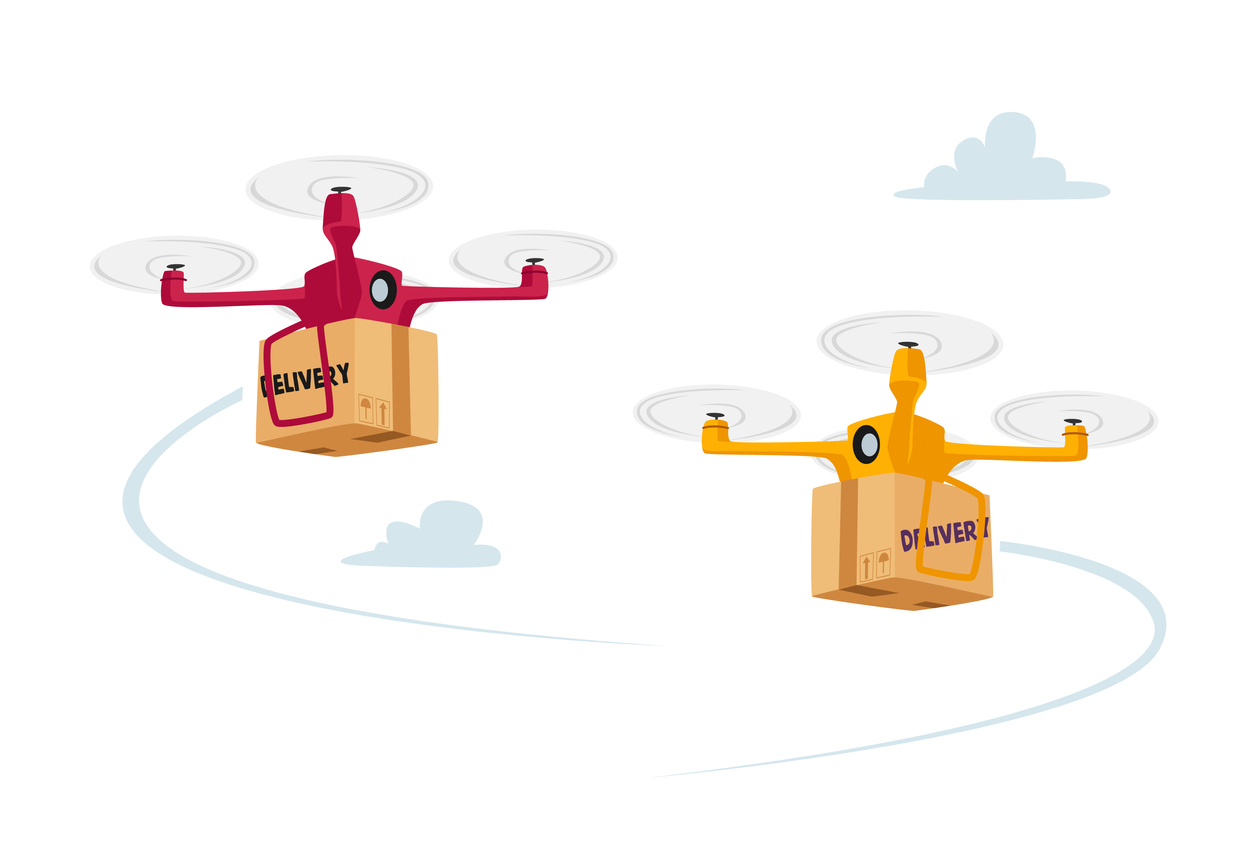The Future Is Now: How Drone Delivery in eCommerce Will Impact Businesses

Unmanned aerial vehicles delivering packages to people’s front doors may seem like something out of a science fiction movie. But in reality, drone delivery in eCommerce very much exists today. It is also expected to grow significantly within the next few years.
Largely confined to urban areas and major brands, eCommerce drone delivery promises a faster, more reliable mechanism to get orders and packages to their destinations. But of course, it comes with some challenges that are impossible to ignore as a more extensive range of online stores looks to explore and potentially implement the technology in the future.
Can you expect to implement drone delivery for your online sales in the near future? The answer, of course, “It depends!” Let’s dig into:
- The history and nuances of drone delivery in eCommerce
- Its advantages and disadvantages
- What it means for the future of online retail
The History of eCommerce Drone Delivery
What long seemed like a fantasy became a reality for the first time in 2016 when Domino’s partnered with Flirtey to drop off two pizzas for lunch at a customer’s house in Whangaparaoa, New Zealand. The delivery took less than five minutes. It also set off tests of similar deliveries in Australia, Belgium, France, The Netherlands, Japan, and Germany.
In 2017, Amazon joined the fray when its Prime Air service dropped off an order of sunscreen at a conference on the topic in Palm Springs, California. Postal services soon joined the race. By May 2020, UPS had delivered more than 3,700 orders of medicine to retirement homes in Florida.
The Major Brands Leveraging Drone Delivery for Online Sales Today
The last six years have made one thing clear. Drone delivery is a high-stakes race, with plenty of companies looking to get ahead or join in. For example:
- Amazon is rolling out drone deliveries on a mass scale for the first time in California this year.
- Wing, a subsidiary of Google’s parent company Alphabet, began using delivery drones from Walgreens and other local retailers in Texas on April 7.
- Years after its initial test, Domino’s is looking to integrate drone delivery into its regular supply chain in the near future.
- Walmart is looking to expand its drone delivery network to 37 locations by the end of 2022. This will expand their service to a range of four million customers.
- In China, online giant Meituan has delivered more than 19,000 meals in its pilot programs of drone food deliveries. Its biggest competitor, Alibaba’s Ele.me, is not far behind.
Meanwhile, an increasing number of logistics companies are also expanding their service opportunities. UPS, FedEx, DHL, and others are all jumping at the opportunity to make their supply chain more efficient while offering alternative delivery mechanisms.
5 Pros and Cons of Drone Delivery in eCommerce
The technology is still just scratching the surface of drone delivery possibilities. Still, the increasing opportunities connected with drone delivery in eCommerce allow us to consider some common opportunities and challenges that are worth examining further.
5 Advantages of eCommerce Drone Delivery
- Delivery Speed. Through drones, eCommerce deliveries no longer depend on fast traffic or clear city roads.
- Sustainability. Drones are more environmentally friendly than other delivery mechanisms, offering potentially significant energy savings.
- Cost Savings. Decreased energy costs, faster delivery times, and natural autonomy mean lower costs for online stores and their customers.
- Potentially Increased Cart Conversion Rates. Thanks to both lower costs and faster delivery speed, customers may more easily commit to a purchase.
- Safety. Fewer vehicles on the road mean fewer accidents and a lower chance of injuries or fatalities.
5 Disadvantages of Drone Delivery in eCommerce
- Weight and Distance Limitations. To date, drones have been primarily limited to last-mile delivery. That restriction makes them most viable in urban centers.
- High Barriers to Entry. Initial implementation costs may be high, making this option more difficult to implement for small stores.
- Potential Privacy Risks. Drones need automated cameras and GPS systems to navigate, which could introduce issues if the data isn’t stored securely and anonymously.
- Ethical Concerns. At least initially, drones will be responsible for the loss of some unskilled labor, introducing ethical concerns for companies (and their customers) championing the workforce.
- Weather Vulnerabilities. Wind and rain can significantly affect the reliability of this service. It may be potentially unreliable in regions experiencing all four seasons.
How eCommerce Businesses Will Be Impacted by the Future of Drone Delivery

We’re still at the experimental phase of drone deliveries. Still, a future in which it becomes the norm (or at least a regular option alongside other delivery mechanisms) is getting closer by the day. Already, companies are beginning to offer partnerships with smaller eCommerce merchants for potential pilots. The above-mentioned Wing, Amazon Prime Air, and UPS are just some of the brands embracing the technology’s possibilities for local businesses.
The fact that we’re still moving towards longer-distance deliveries and more cost-effective entries is also important to keep in mind. Even if drone delivery isn’t yet viable for all eCommerce merchants, it soon might be. Lower costs, faster delivery, and increased customer satisfaction all make a compelling argument for both researching current options and evaluating future opportunities.
Preparing for this future means reviewing your current technology and estimating its viability in potential integrations. Your customer ordering system, for instance, should be able to integrate with both a warehouse ERP and drone server to seamlessly transfer data. An early evaluation can play a significant role in eventual implementation.
Even if drone delivery is not viable for your situation, store, or audience, understanding the technology and its potential opportunities will be vital. Competitors may make the switch in the near or long-term future. When they do, this may force you to adjust your shipping options or costs to remain competitive.
Either way, being prepared for the future of drone delivery will be vital to building and sustaining a competitive advantage or fighting off your competitors’ potential advantage. The good news is you don’t have to be on your own. So contact us for a potential partnership, and learn how we can help you be well prepared for the present and future of eCommerce.


